|

Friday,
September 8, 2006
 Labor
Day Weekend 2006
- Cara Lynn, Eric and I headed up to the North Rim of the Grand
Canyon, to spend the Labor Day Weekend camping and enjoying the Big
Saddle Trail, which leads to the Esplanade level of the canyon.
Although the trail goes many miles, to Muav Saddle, it is only easy to
follow to Lower Crazy Jug Spring. The trail is a prehistoric
Indian trail. Although there are no ruins in the immediate area,
the trail does pass by an Labor
Day Weekend 2006
- Cara Lynn, Eric and I headed up to the North Rim of the Grand
Canyon, to spend the Labor Day Weekend camping and enjoying the Big
Saddle Trail, which leads to the Esplanade level of the canyon.
Although the trail goes many miles, to Muav Saddle, it is only easy to
follow to Lower Crazy Jug Spring. The trail is a prehistoric
Indian trail. Although there are no ruins in the immediate area,
the trail does pass by an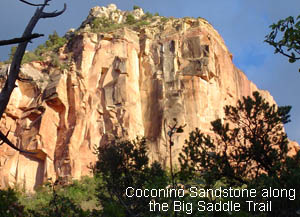 intriguing pictograph, similar to ones seen further north, in Snake
Gulch. Perhaps a hundred years ago, the trail received a major
makeover, as cowboys herded cattle in this basin during the
winter. There is a crumbling cement trough along the upper
trail, and barbed wire fencing at three spots above the Coconino
sandstone, and two spots below. In the 1960s, famed Grand Canyon
hiker, Harvey Butchart, reported seeing a horse party in this area,
returning from a trip to Powell Plateau. Never having heard of
this trail, Butchart decided to follow it on his return, topping out
at the rim near the old Big Saddle hunting camp. Since then,
very few people have trekked over this part of the Grand Canyon.
intriguing pictograph, similar to ones seen further north, in Snake
Gulch. Perhaps a hundred years ago, the trail received a major
makeover, as cowboys herded cattle in this basin during the
winter. There is a crumbling cement trough along the upper
trail, and barbed wire fencing at three spots above the Coconino
sandstone, and two spots below. In the 1960s, famed Grand Canyon
hiker, Harvey Butchart, reported seeing a horse party in this area,
returning from a trip to Powell Plateau. Never having heard of
this trail, Butchart decided to follow it on his return, topping out
at the rim near the old Big Saddle hunting camp. Since then,
very few people have trekked over this part of the Grand Canyon.
We arrived at a campsite, along the rim (and, still in the National
Forest) late Saturday morning. In the afternoon, Eric and I
hiked down to the top of the Coconino, where a very marginal fault has
left one side about two feet higher than the other. It is just
enough to create a narrow, and rather spectacular, passage through
this impressive rock layer. For those of you with copies of the
Geologic Map of the Grand Canyon - this fault is not marked on the
map!
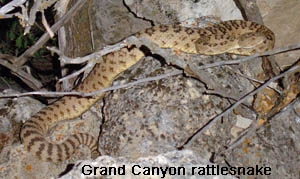 On Sunday, all three of us trekked down to the Esplanade, a broad
plateau that dominates this region of the Grand Canyon. We
detoured west of the Lower Crazy Jug Spring, in an attempt to better
locate the route to another spring, the Lower Big Saddle Spring, which
is in the north-running ravine and tumbles over some Supai cliffs
alongside an impressive pinnacle of rock. The trail is rather
obscure through here, although there are still occasional caches of
fencing along the route. We got a few sprinkles of rain in the
mid-afternoon, and all bundled up in our ponchos. It did not last
long, but did cool things down quite nicely. In the late
afternoon, Eric and I stopped off at the Lower Crazy Jug Spring, to
top off our water bottles for the hike out. As we were racing up
through the switchbacks in the Coconino, Eric was startled by a sudden
noise. He jumped back in surprise, as he was about two feet away
from his first Grand Canyon rattlesnake. It was not only an
impressive specimen, but it was located in a good spot for a photo! That, in my humble experience, is a rarity. We
backed off a bit, and, perhaps, a bit too far. By the time we
decided on a path to follow, the snake was gone! We quickly
hopped over about 20 feet of rocky trail, hoping that it hadn't
decided to move into those rocks. Well, we didn't hear, nor see,
anything else. Later, Cara Lynn told us that she, too, had seen
a rattler, but one much smaller. Our detour for additional
water, which turned out to be unnecessary, caused us to finish up our
hike by the light of a three-quarters full moon. It was a full
and rewarding day for all.
On Sunday, all three of us trekked down to the Esplanade, a broad
plateau that dominates this region of the Grand Canyon. We
detoured west of the Lower Crazy Jug Spring, in an attempt to better
locate the route to another spring, the Lower Big Saddle Spring, which
is in the north-running ravine and tumbles over some Supai cliffs
alongside an impressive pinnacle of rock. The trail is rather
obscure through here, although there are still occasional caches of
fencing along the route. We got a few sprinkles of rain in the
mid-afternoon, and all bundled up in our ponchos. It did not last
long, but did cool things down quite nicely. In the late
afternoon, Eric and I stopped off at the Lower Crazy Jug Spring, to
top off our water bottles for the hike out. As we were racing up
through the switchbacks in the Coconino, Eric was startled by a sudden
noise. He jumped back in surprise, as he was about two feet away
from his first Grand Canyon rattlesnake. It was not only an
impressive specimen, but it was located in a good spot for a photo! That, in my humble experience, is a rarity. We
backed off a bit, and, perhaps, a bit too far. By the time we
decided on a path to follow, the snake was gone! We quickly
hopped over about 20 feet of rocky trail, hoping that it hadn't
decided to move into those rocks. Well, we didn't hear, nor see,
anything else. Later, Cara Lynn told us that she, too, had seen
a rattler, but one much smaller. Our detour for additional
water, which turned out to be unnecessary, caused us to finish up our
hike by the light of a three-quarters full moon. It was a full
and rewarding day for all.
On Monday, we packed up and headed out.
We had come in over the dirt roads from Jacob
Lake, but returned to the highway at the Kaibab
Lodge. The effects from the Warm Fire (see stories here,
and here
and here)
were quite apparent, as you can tell from the photo at the top of this
blog (click on it
for a larger image). The
photos, below, came from a NASA site and you can see the
far-reaching effects of the smoke from this fire, blanketing vast
amounts of the Grand Canyon. [As an aside . . . I wonder how
much that contributes to global warming? And, please, put it
into the equivalent of auto miles traveled. Then, tell me that
it is a good idea for the Forest Service to let these kinds of fires
burn.] Well, the locals were quite p.o.-ed with the Forest
Service, and we saw (and signed) petitions asking for an inquiry into
the policy of letting such a fire burn at the driest time of the year!
|
|
Sunday,
September 10, 2006
 The
Enemy is the State
- Arizona Governor, Janet Napolitano, has set in motion actions
that will hamper economic growth and development in the state.
Well, actually, she does that all the time. But, in this
instance, it is part of the radical left global warming cult that is
driving these actions. Last year, she put together a pork barrel
commission to make recommendations about cutting greenhouse
gases. And, guess what? They did. And, they're
pretty awful. And, she is promising to follow through with
them. [See the report
here.]
The use of the state to encourage, convince, cajole, tax and subsidize
us into reducing absolute levels of these greenhouse gases has got to
be a bigger infringement on our liberties and freedoms than listening
in on foreign telephone calls to known terrorists, but you wouldn't
know it from reading the paper or watching the news. The
Enemy is the State
- Arizona Governor, Janet Napolitano, has set in motion actions
that will hamper economic growth and development in the state.
Well, actually, she does that all the time. But, in this
instance, it is part of the radical left global warming cult that is
driving these actions. Last year, she put together a pork barrel
commission to make recommendations about cutting greenhouse
gases. And, guess what? They did. And, they're
pretty awful. And, she is promising to follow through with
them. [See the report
here.]
The use of the state to encourage, convince, cajole, tax and subsidize
us into reducing absolute levels of these greenhouse gases has got to
be a bigger infringement on our liberties and freedoms than listening
in on foreign telephone calls to known terrorists, but you wouldn't
know it from reading the paper or watching the news.
Among the actions to be taken is one that mandates more severe
restrictions on auto manufacturers, if they want to sell cars in the
state. What will this accomplish? Higher prices.
Less selection. And, if you really want a brand new Hummer,
you'll just have to drive to Utah to get one. Who will be harmed
most from this action? Those at the lower end of the income
spectrum, of course. They always are. Government
restrictions, controls and mandates always have a disproportionate
effect on the less well-to-do.
There is one hopeful roadblock to this - the governor has to rely on
"the power to reduce 'air
contaminants' from motor vehicles. [Sierra Club lobbyist Sandy]
Bahr said she would argue that carbon dioxide fits the definition of a
contaminant." [Arizona Daily Sun, 9/9/06, p.
A8] That's pretty heady stuff, considering that CO2 is what we
exhale and what plants rely on to survive! Defining that as a
"contaminant" is . . . well, I can't even think of a word
that adequately conveys the sheer lunacy of such an outcome.
Take a look at the state's list of air
pollutants, and you'll find things like acetone and barium and
uranium 238, but you won't find carbon dioxide.
As if to add insult to injury, the governor is also calling for HOV
lanes to be open to hybrid cars, even if there is only one person
riding in them. I feel like Jon Stewart, on the Daily
Show, rubbing my eyes and going, "Waaaa?" The HOV
lanes are there to help relieve traffic congestion. Now, they
are going to be used to reward consumers that buy politically-correct
automobiles? I hate to think about what is next.
One more awful idea - using state funds
to promote the consumption of locally grown food (see page 82 in the
report cited above). Ouch! It is an example of how
policymakers are no substitute for the marketplace. Businesses
have every incentive in the world to reduce the total cost of their
products, not just a particular cost. By ignoring this
fundamental characteristic, the state is likely to raise total
costs. And, what about communities in northern Arizona?
Shouldn't the state encourage us to consume food produced in nearby
states, because they are closer to us than is southern Arizona?
Somehow, I don't think that their moral righteousness extends beyond
the state's border.
|
|
Monday,
September 11, 2006
 9/11
- Remembering David Tengelin
- Among the thousands of victims of 9/11 was 9/11
- Remembering David Tengelin
- Among the thousands of victims of 9/11 was 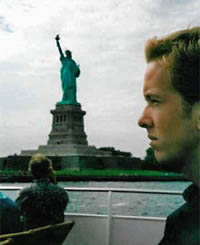 former
College of Business Administration graduate (at Northern Arizona
University), David Tengelin. David was a management major, and
graduated in December of 1999. He traveled to Arizona from his
home in Sweden and was captivated by America. He wanted to work
in New York City, so he went job hunting there after his time at the
CBA. He found a job with the global insurance broker, Marsh
& McLennan Companies. MMC had offices on the former
College of Business Administration graduate (at Northern Arizona
University), David Tengelin. David was a management major, and
graduated in December of 1999. He traveled to Arizona from his
home in Sweden and was captivated by America. He wanted to work
in New York City, so he went job hunting there after his time at the
CBA. He found a job with the global insurance broker, Marsh
& McLennan Companies. MMC had offices on the 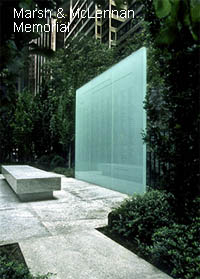 93rd
through 100th floors of the North Tower of the World Trade
Center. On March 10, 2001, he wrote of his new environment . .
. 93rd
through 100th floors of the North Tower of the World Trade
Center. On March 10, 2001, he wrote of his new environment . .
.
It's
when I walk up to the window in our new offices on the 100th floor of
One World Trade Center, that I realise how incredibly lucky I am.
I
see Manhattan laid out at my feet almost like a roadmap, and every
landmark is distinguishable.
The
fifty-floor skyscrapers crouch humbly; at our height we're alone with
the jets.
It was directly into these floors that the first plane hit the WCT
(American Airlines Flight 11). Along with 294 of his co-workers,
David perished in this attack. MMC 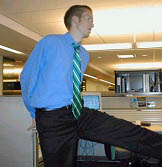 employees
(and consultants) accounted for nearly ten percent of the casualties
on that day of terror. [The memorial photo, to the right, is
linked to the MMC tribute page, where you can read more about David
and his fellow workers.] employees
(and consultants) accounted for nearly ten percent of the casualties
on that day of terror. [The memorial photo, to the right, is
linked to the MMC tribute page, where you can read more about David
and his fellow workers.]
"He
enjoyed studying and learning new things. School was an
important part of his life, and he loved his college years and
the friends he made."
--Petra (David's sister) |
David was the
kind of student we want to have - highly motivated, interested in
the world around him, and persistent in pursuing his dream. He
did exactly what we want students to do after graduation - go out
into the marketplace and contribute to the incredible process that
has been raising our standards of living for hundreds of years.
|